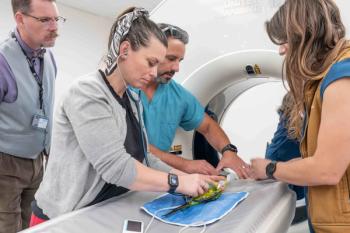
Ultrasound-guided biopsy: Why it is a must have skill (Proceedings)
Learning ultrasound is hard enough! Haven't we done enough just to make accurate descriptions and list most appropriate differential diagnoses?
Learning ultrasound is hard enough! Haven't we done enough just to make accurate descriptions and list most appropriate differential diagnoses? The short answer is maybe. In this talk we will discuss the pros and cons of ultrasound guided interventional procedures. We'll discuss the indications and contraindications and equipment that should be utilized. We will try to add a component of economic importance to this discussion.
At the University of Illinois that in her teaching hospital approximately 70% of all for some patients have an interventional procedure. This may be as simple as a sister some pieces or is complex is an extremely difficult core or fine needle aspiration. The prevalence of this procedure in our practice makes it vital for both providing high-quality medical care and is a major source of income to the hospital. It is very common for our clinicians not to be very concerned about the description of the ultrasonic graphic findings, but rather insistent upon a diagnostic sample of liver, spleen, etc. Even many normal appearing organs may be a site to perform a fine needle aspiration under certain circumstances, such as the spleen in certain cases of mass cell tumor.
The indications to perform intervention are varied. It may be as simple as elevated liver enzymes of the appearance of nodules within the liver parenchyma. Generally, any nodule, mass, fluid pocket is fair game for a fine needle aspiration. Core biopsy is done very infrequently and only in very specific circumstances (e.g., liver in cases of copper storage disease or chronic active hepatitis). We've had very good luck with most diseases using fine needle techniques.
Equipment necessary to perform fine needle aspiration is quite simple and inexpensive. A 22 or 25gauge needle of appropriate length attached to a 5 to 10 mL syringe is all that is required. Limited patient preparation is required. Rarely do we need to assess platelet number or coagulation status for such a limited study. The gel is removed from the patient and isopropyl placed for coupling. Any residual gel in the needle path may result in a basophilic haze on the cytologic sample making it nondiagnostic. The needle is then inserted through the skin and into the area of interest whereafter multiple agitations of the needle are made to pack the needle with cells and quickly withdrawn. We usually perform 3 aspirations but in certain circumstances may just perform a single aspiration. This is usually dependent on patient clinical concerns. Use of larger gauge needles should be considered when drainage is of interest. This would include pericardial sac, any abscess for even the peritoneum. I find that 25gauge often gives me a good diagnostic sample and is much less painful, especially in older cats. In one study performed in Australia, 25 gauge samples were as good as or better compared to 22gauge. However in our institution, there is a bias against 25gauge and our clinical pathologists prefer larger samples obtained with 22gauge needle. The downside to the larger gauge is increased likelihood of hemodilution and pain to the patient.
Problems associated with interventional procedures are usually limited and mild. Bleeding is inevitable but usually not detectable. An exception is with especially friable tissues such as livers with hepatic lipidosis or spleen with lymphoma. Many apparently dangerous structures may be samples with lower than anticipated morbidity, such as the pancreas. Although we were historically told not to perform fine needle aspirations when the pancreas was inflamed, there is no clinical basis to suspect that fna of this organ is more likely to result in serious clinical effects than any other organ. The most likely cause of morbidity is missing your target. This is very easy especially early in your learning curve. It is usually also associated with increased duration of your biopsy efforts. They longer the procedure, the more likely there will be morbidity. Fast and efficient should be your motto. However, this requires experience and appropriate skills.
Learning to perform these procedures will require a certain amount of confidence and a good quality ultrasound machine system. Beginning with phantoms is often preferred by neophytes. This could be a gel phantom made with cooking gelatin and flour mixture or a raw turkey breast. But eventually you will have to start performing procedures on your patients. I recommend beginning with cystocentesis. This is a procedure that you do not need ultrasound for, and therefore will feel more comfortable beginning your ultrasound guided efforts. This is relatively simple because, 1) the target is big, 2) the target is superficial, and 3) when you are inside the target the needle will be very bright against the dark black background. After you develop some comfort with this procedure I recommend beginners move on to free fluid sampling in the peritoneum. Eventually you will work up to the pleural space in the chest and other more exacting sites. The liver is probably the most common site for us to perform a fine needle aspiration. This is either due to liver enzymes being elevated or detection of echogenic lesions such as nodules. These can be easy or extremely difficult depending on the depth of the lesion, patient movement (such as panting) and other clinical concerns. Eventually you'll get down to very small lesions including the gastrointestinal tract, lymph nodes and other small nodules. The limit of targets is only based on your experience and skills. For example, how small of a nodule to feel comfortable performing at aspirate upon in the lung, knowing that if you miss the target you will cause pneumothorax? Again, everyone has their limitations where they say, " I don't think so".
In summary, interventional ultrasound techniques are extremely common and usually very safe. In addition they significantly add to the quality of medical care being provided to the patient's and provides a diagnosis of many diseases with a simple, brief procedure. Just as important it is a substantial economic boost to your practice. Again, 70% of all of our patients in ultrasound have some form of interventional procedure performed. If you are performing 10 ultrasound examinations a day and with a hypothetical cost of $30 per fna, daily income would be over $200, not counting the additional fee for psychological evaluation with very little overhead involved. I strongly recommend that when your skill sets are at an appropriate level, that you take on the additional task of performing interventional ultrasound procedures. These procedures are clinically very reward
Newsletter
From exam room tips to practice management insights, get trusted veterinary news delivered straight to your inbox—subscribe to dvm360.






